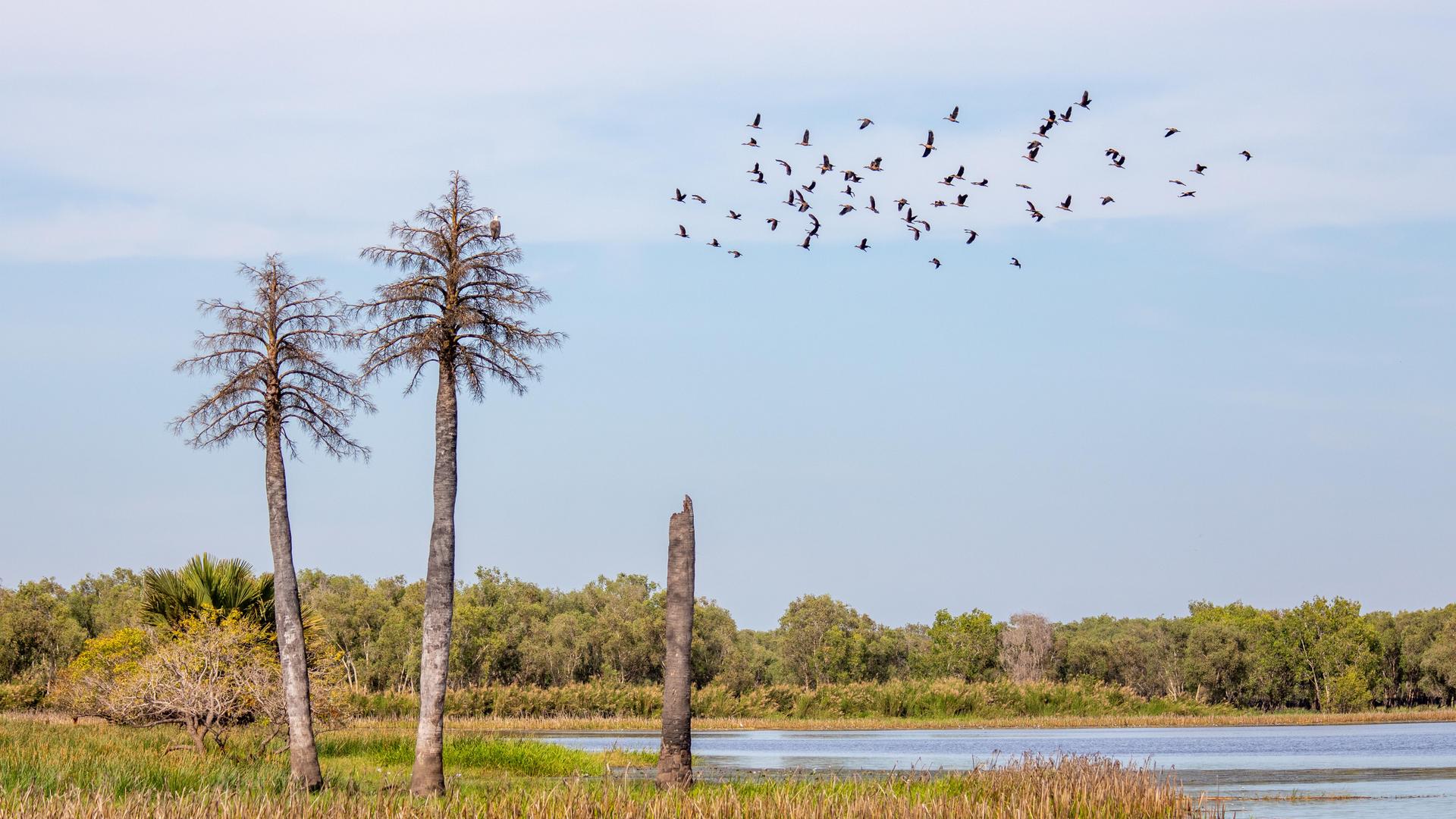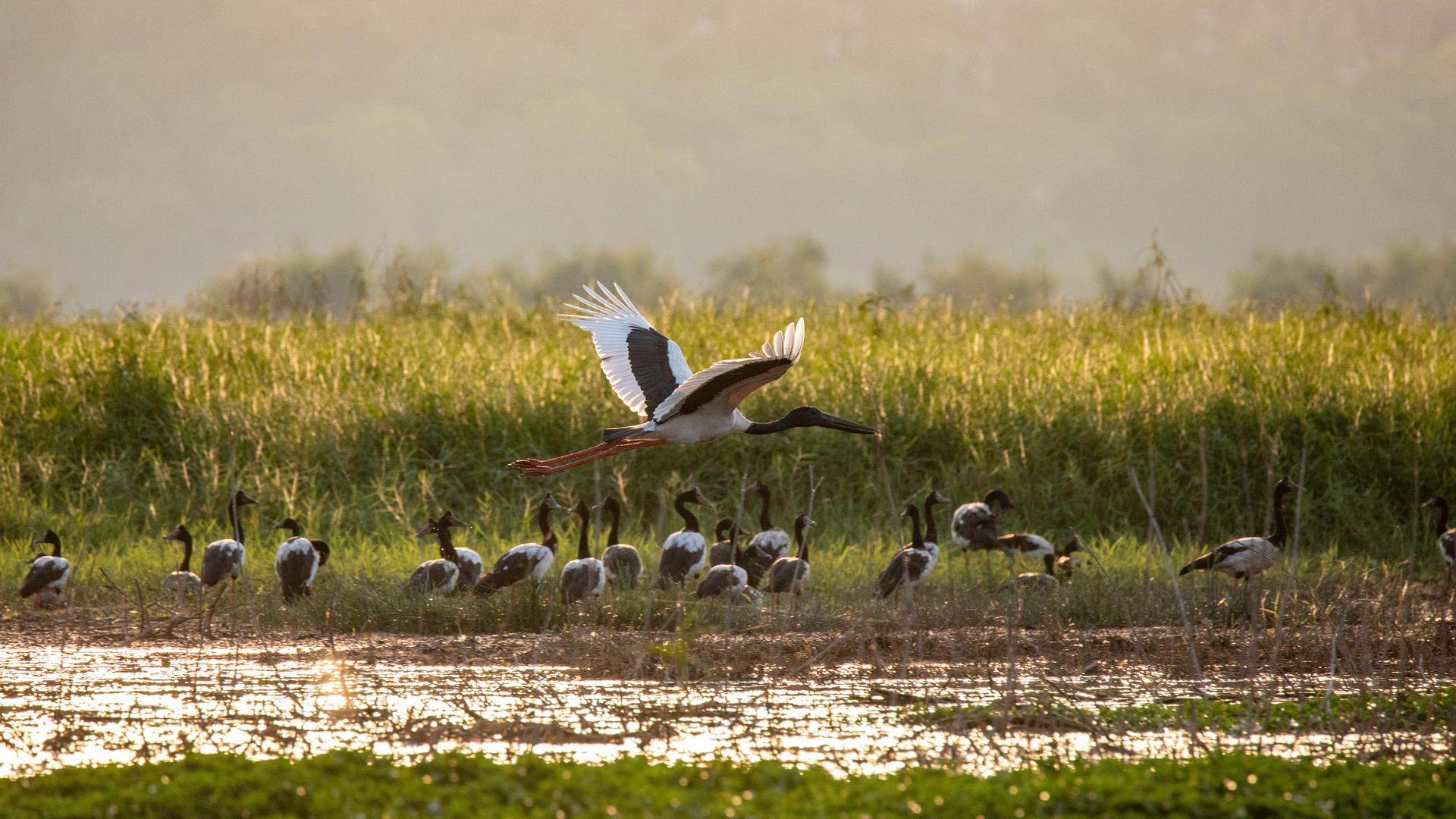Learn new things in the company of one of our oldest cultures.
WORDS Carolyne Jasinski
Barefoot and machete in hand, Marcus walks us into the wilderness of East Arnhem Land. He stops by a stringy bark tree and pulls at the crisp shards revealing a moist layer underneath.
“If you get a sore throat or a tooth-ache, you can drink tea made from the inner bark,” he says.
“It’s also good on insect bites.”
Marcus is an elder in the Aboriginal community of Nyinyikay and this is our introduction to the Bush Encyclopedia. To Marcus’s family this is just life. They are in tune with their surroundings and watch for nature’s cues. But to us, it’s an eye-opening experience and one that redefines “getting back to nature”.
A Kurrajong bush grabs his attention.
“When the red flowers appear, it’s a sign that baby sharks are being born,” he smiles. “It’s time to go fishing.”
Dead kurrajong is also good for fire.
Marcus talks about using the seasons to survive and thrive in the tropics – but not just the Wet and Dry.
“For us, there are eight seasons which apply to the sea and land, animals and vegetation,” he says.
“And we use all of them … like the vegetation telling us when the fish are coming.”
We learn to watch out for caterpillars with spikes. One got Marcus but he knew how to treat the wound.
“If it’s a bad bite, you have to kill the caterpillar, crush it and use the mixture as a salve,” he says.
Of course, the tropical vegetation also provides food. We’re surrounded by beautiful palm trees with distinctive fan-like fronds. Just under the shoots of these fronds is the heart of the palm which, apparently, tastes like cabbage. Eating this heart will kill the palm. But that’s not the end of its useful traits. The dead trunk, resembling a log with scales, has a hollow tip and tinder inside. Pull out the tinder, stuff it back inside the hollow then light it for a torch.
Our walk among nature with Marcus has us all thinking every plant must have a special use.
“What about this one,” a guest says pointing out a big specimen with large floppy leaves.
“No. Just a tree,” Marcus laughs.
It’s time to move to the mangroves.
With the clear blue waters of Arnhem Bay as a backdrop and Marcus’s daughters searching the reef, collecting oysters for breakfast, the informal lessons continue.

Looking for cockles? The best place is between the sand and the mangroves, and you need to look for the profile edge because cockles lie with their opening at the top.
The beach is crawling with hermit crabs. Are they edible? No. The Yolngu people believe they have a strong connection to the winds, so they leave them alone. That and the fact that it’s too much trouble – they are tiny, so don’t provide much meat.
Talk turns to fishing. Marcus and his boys love stingrays. Cooked on coals, the livers, high in protein, are the best bit.
When is the best time to catch them?
“We spear them when their lips are fluoro yellow,” he says.
But that can be tricky.
“If you get stung by a ray, don’t pull the barb out, push it through,” he says. “The barbs face backwards.”
“Then find a cockroach, squash it and squeeze it into the sting hole – it’s a natural antidote to the poison.”
The tide is out, so our fishing expedition continues at the mouth of the river.
“The only reason we’re here is because the tide is out and the crocodiles are further upstream,” Marcus states.
“When the tide changes, we will have to get out of here. That’s when the crocs wake up and they’re more active.”
The river is reduced to a fast-flowing stream. We spend a few hours catching rock cod and barracuda.
Then Marcus notices the tiniest change in water flow.
The tide is coming in … and we’re off … over the mudflats with cockles, fish and mudcrabs to higher ground.
As we wait for the fish to cook in leaf parcels on hot coals, Marcus explains that to the Yolngu, land is not real estate – it’s life. Spiritual.
He tells us about the importance of songlines to his people and keeping their history alive.
“Our songlines are our history books,” he says.
“They all have a start, middle and end. But the end is not where is finishes – it’s where a new connection starts to another clan and their songlines.
“Songlines carry us a long way – they are a bit like psalms in the Bible. They represent past and present and lead to the future.”

MEN’S AND WOMEN’S BUSINESS
In Yolngu culture there are things that women do and other tasks delegated to men. I can tell you very little about what the men got up to during their time alone.
“We could tell you but we would have to kill you,” they joked.
The most we discovered was that they searched for the perfect materials, then carved spear launchers … and learnt how to butcher a kangaroo for dinner.
Weaving with the women provides a much more pleasant chapter for the Bush Encyclopedia. There are lessons to be learnt sitting for hours, talking with Marcus’s wife Dianne and mother, Megan. The first is patience and admiration – basket weaving is not as easy as you might think.
First we take another walk into the bush to find the pandanus that is split and dried to make strings, and to dig for the red rooted plants used to dye them.
Then the “work” begins. We’re taught how to weave earrings, baskets and bowls. Our lack of talent is forgiven by these lovely women and our creations “fixed” when we stop for lunch.
We’re also given a rare opportunity to completely relax. There are no clocks, no deadlines, no expectations and no phone reception. Travelling through Arnhem Land is your chance to switch off and feel more connected than ever before.
BY INVITATION ONLY
There are a few things you need before heading into Arnhem Land. The first is an invitation – you have yours thanks to Outback Spirit. The second is a sense of discovery for this is no ordinary tour – more a lesson in life.